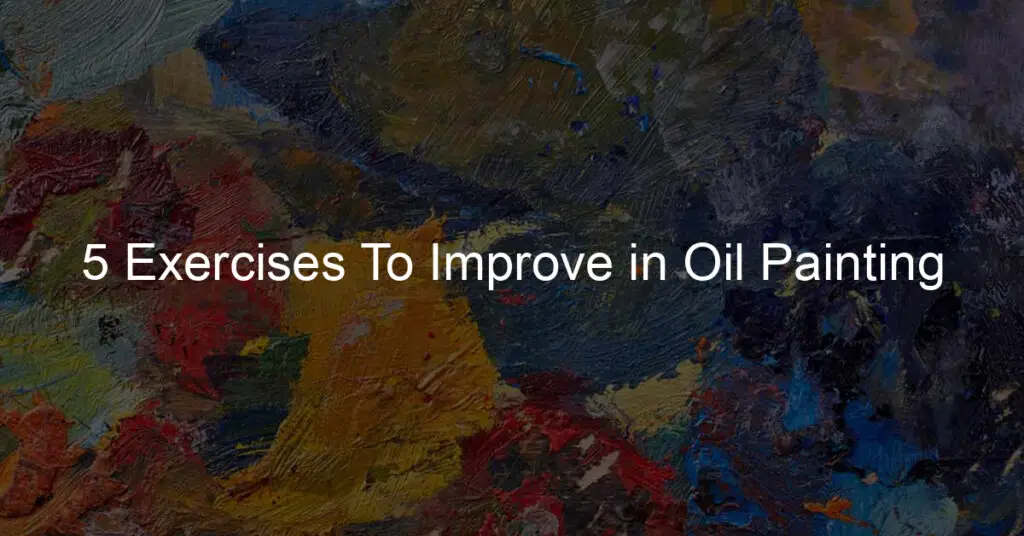If you're an oil painter, it can sometimes be challenging to break out of your old habits and take your painting skills to the next level. Whether you've been painting for years or are just starting, there's always something new that we can learn. That's why I'm here to help with five fun exercises specifically tailored to improving oil painting!
In this blog post, I'll give you some tips on how to practice and progress so that you can create stunning works of art with oils. So get ready for a journey into the exciting world of brush strokes and color blending:
1. Start With A Sketch: Before you start painting, make sure to do a quick sketch of your design idea. This will help you visualize the result and also give you an outline so that you don't get lost in your brushstrokes when working with oils.
2. Color Blending & Layering: Once you have your sketch in place, start to add layers of oil paint. Use different colors and blend them with a brush or a palette knife. This will create interesting textures and effects that will take your painting to the next level.
3. Experiment With Brush Strokes: Try out different kinds of brush strokes such as stippling, hatching, cross-hatching, and scumbling. This will bring texture and depth to your painting.
4. Practice Color Theory: Spend some time researching and practicing color theory. Knowing the basics of color combinations such as complementary colors, triadic colors, and analogous colors can help you create more vibrant paintings that stand out!
5. Have Fun With It: Don't be afraid to get creative and have fun with your painting. Experiment with different mediums, textures, and techniques to create a unique piece of artwork that you can truly be proud of!
Should I learn to draw before oil painting?
If you're planning to tackle a serious oil painting project, it might be a good idea to first learn how to draw. Drawing is the foundation of all forms of art and will help you build your skills so that painting in oils becomes easier and more natural.
It's also important to understand color theory and composition when it comes to oil paintings, but having drawing experience is essential if you want to create masterpieces. Learning a few basic drawing techniques before diving into oil painting can make the process much smoother and less frustrating for beginners.
What skills are needed to be a painter?
Everyone has their definition of what makes a successful painter. But there are some key traits that all painters need to cultivate. First, it requires patience and a strong eye for detail. Painters must have the skill to translate their artistic vision into reality with both precision and accuracy.
Secondly, painting requires technical know-how and mastery of basic art principles, such as composition, value, perspective, color theory, and more. Lastly, having good communication skills helps people collaborate effectively and share their creations confidently with others. All in all, being a successful painter takes a lot of hard work and dedication – but the rewards from following your passion can be truly priceless!
How can I improve my oil painting skills?
Oil painting is a great hobby to pursue, but like anything else, it requires practice and dedication. To improve your skills significantly, try committing to a regular painting schedule – an hour a day or even once per week can do wonders.
If you are just starting on oil painting, research some foundational techniques like color mixing and brush strokes so that you have a good base of understanding to draw from. Once you've mastered these basics, reference books or YouTube tutorials may help introduce more advanced concepts. Lastly, join an art group or take classes if possible; practicing with experienced painters can help you level up quickly!
How do you practice oil painting?
Oil painting is an art form that has been around for centuries and it continues to be a popular medium for many painters today. To get started with oil painting, the first thing you need to do is assemble the right materials. Depending on your level of experience, you can either start by purchasing an oil painting set or simply grab some quality brushes and paints from an art store.
Next, it’s essential to choose the right canvas and surface to paint on. When you are ready to begin painting, try starting with abstracts and shapes to practice brush stroke techniques before tackling more advanced compositions.
Lastly, don’t forget to take breaks and assess your work in between sessions so that you can stay energized and motivated. Following these steps will help get you well on your way to becoming a masterful oil painter!
Summary: 5 Exercises To Improve in Oil Painting
With these five exercises, you now have the skills to get started and improve your oil painting. Creating art is an enjoyable process, and with practice and determination, your work will become better and better.
Don't be afraid to experiment and think outside the box – use colorful palettes or play with texture to add something extra to your pieces. Oil painting can open up new creative doors that you never knew existed – so go explore them!
And finally, never forget that it's all about having fun – once you let go of perfectionism, you will experience more joy in making art. So grab a canvas, pick out some paints, and get brainstorming – soon enough, your masterpiece will be ready for the world!


















